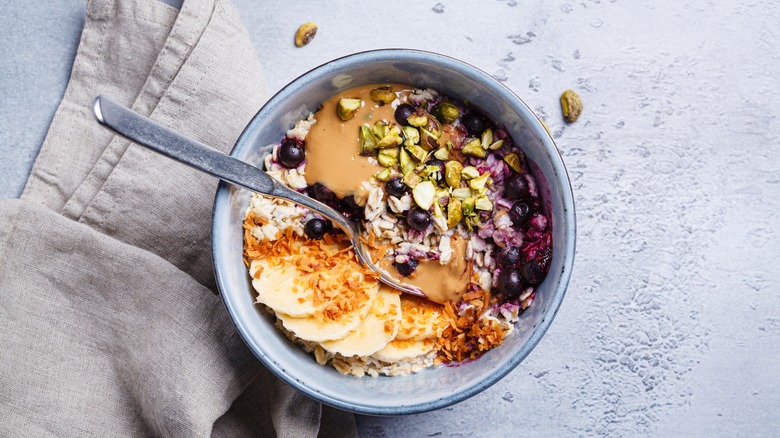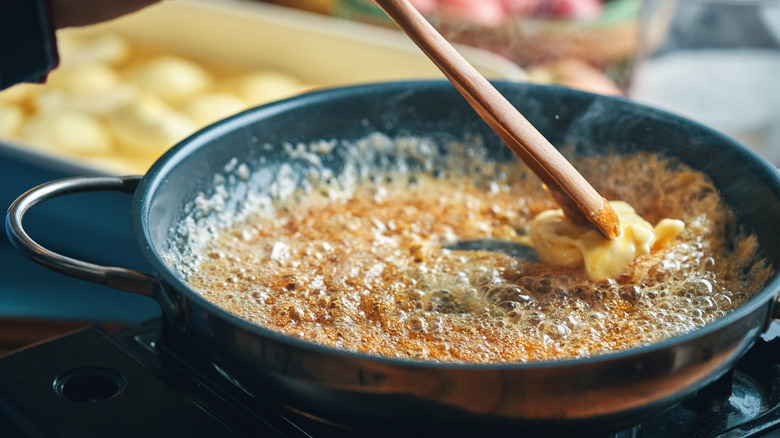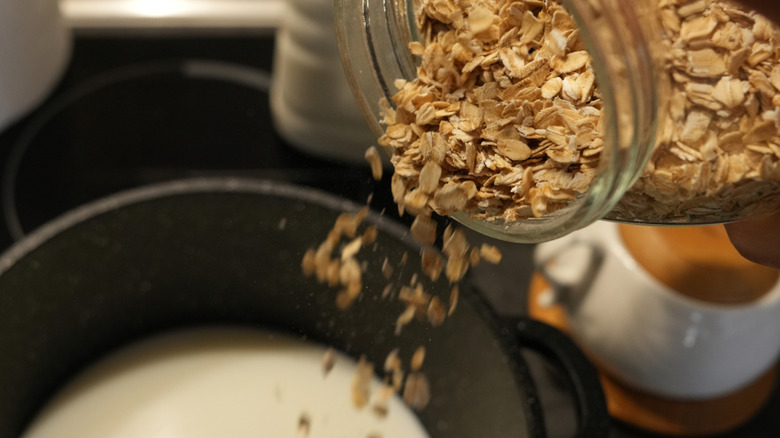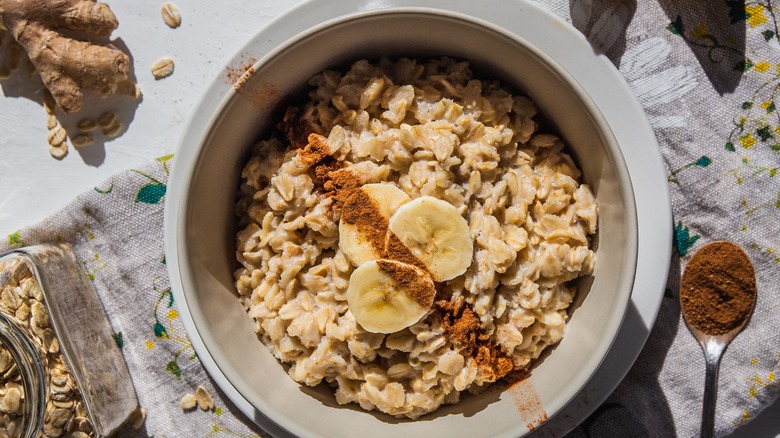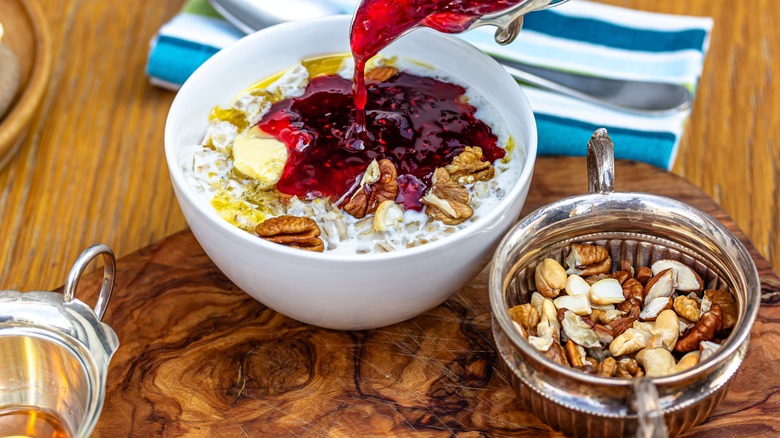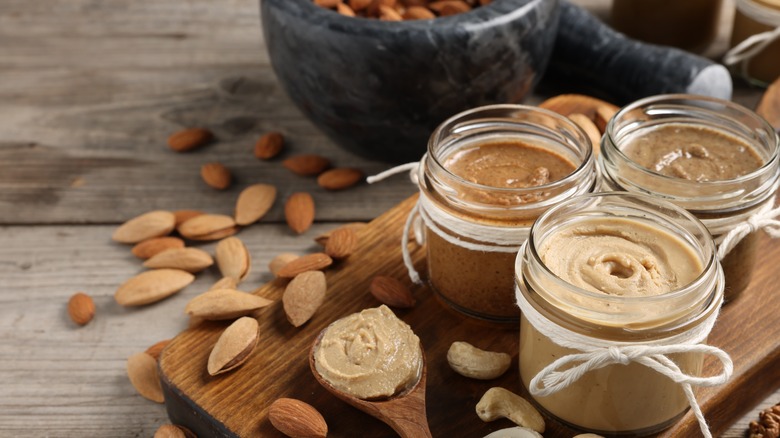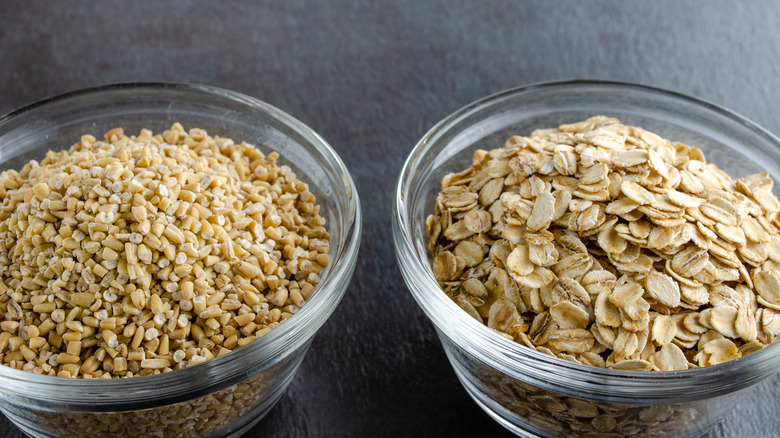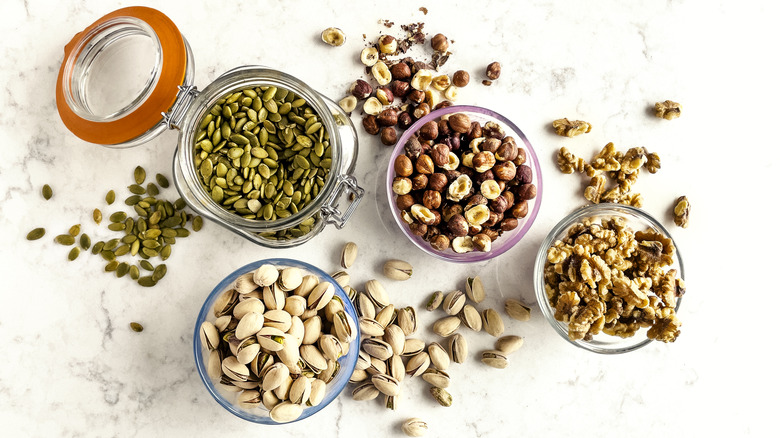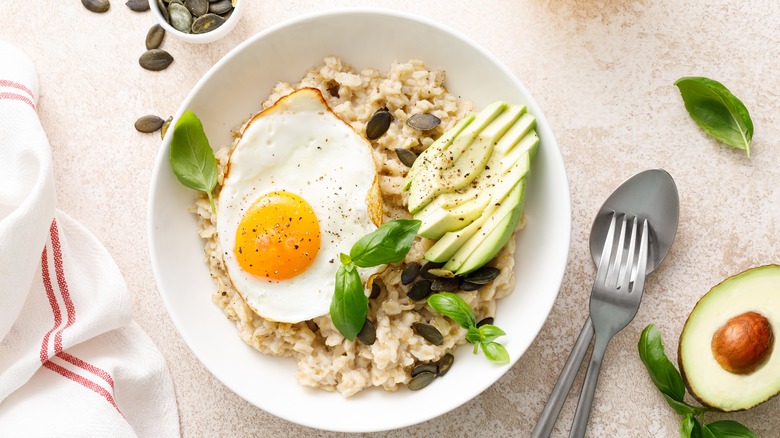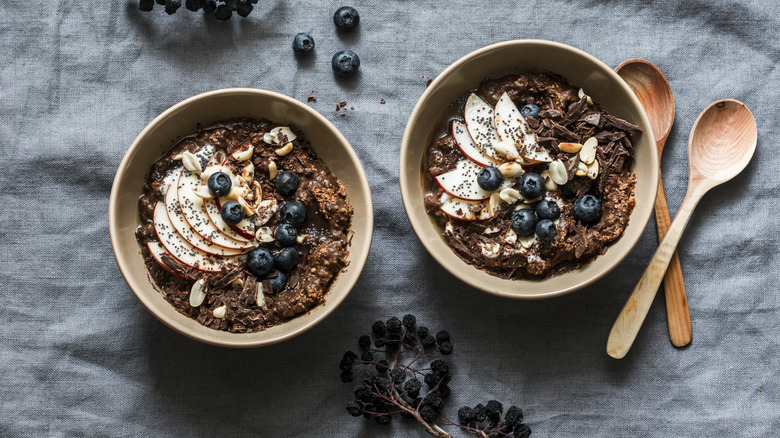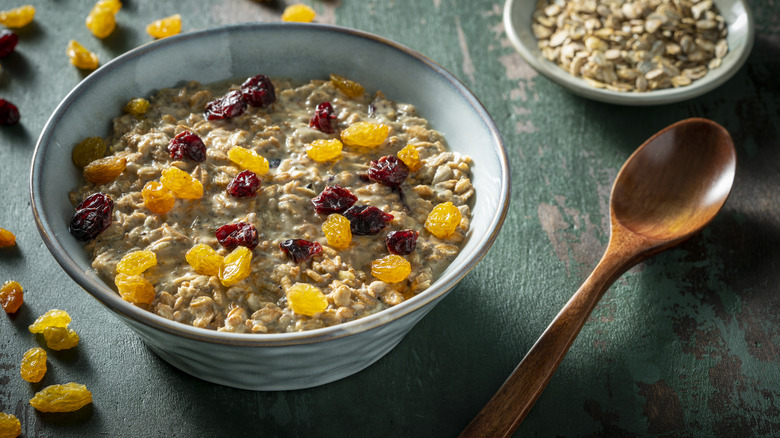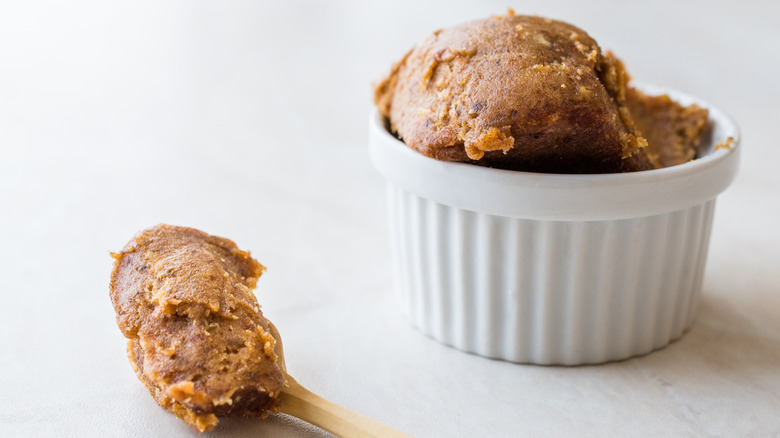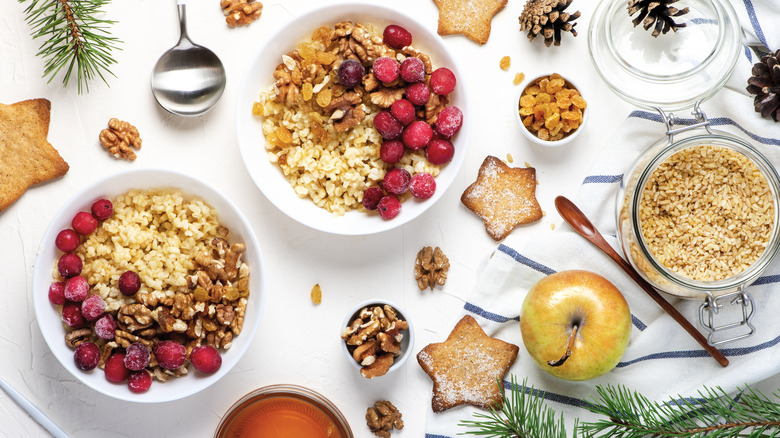Simple Ways To Upgrade Your Morning Oatmeal
Oatmeal is known to be a humble breakfast, but it by no means it has to be boring. With a bit of creativity, oatmeal has the potential to be rich, luxurious, and even decadent. Consider oatmeal a blank canvas — and a few thoughtful upgrades can transform a traditionally bland dish into a standout breakfast layered with flavor.
Oatmeal's reputation has come a long way from the ubiquitous small, sugar laden instant packets, which can disintegrate at first contact with hot water. While standard oatmeal flavors from apple cinnamon to maple brown sugar are delicious, there are so many more possibilities. The secret to a highly customizable, stellar bowl of oatmeal involves toasted oats, a pinch of salt, a creamy component, and finished with innovative toppings. Think miso, chocolate, and even savory granola.
The very best oatmeal is cooked with intention and can be something you wake up looking forward to in the morning. Or even worthy of a special occasion. So, turn the page on instant, gluey, and forgettable oatmeal and try these proven methods to upgrade your morning oats.
Toast your oats in butter
One of the most critical upgrades to oatmeal is toasting your oats in a pat of butter, creating a buttery, rich base. It enhances your oatmeal with a simple extra step — and the effort is worth it. Once the dry oats soak up the butter, add your cooking liquid to the same pot. The upside is twofold: You're still only using one pan and it only takes a few minutes.
An easy ratio to follow when toasting oats is about 1 tablespoon of butter per cup of oats. Stir the oats frequently until they fill your kitchen with an irresistibly nutty scent. To really level up your oatmeal, browning the butter will deepen the flavor so the oats take on delicious, fragrant caramel notes. This method works best with rolled or steel cut oats.
More than taste, toasting oats helps keep their form and do not turn to mush once you add hot liquid. Don't stop toasting your oats for breakfast. Sautéing oats in butter is also the extra step you can't forget when making oatmeal cookies. No matter the usage for your oats, toasting enhances the flavor, automatically making them more aromatic and quite frankly, tastier.
Add a pinch of salt to balance your oatmeal
Once your oats are toasted, adding a pinch of salt intensifies oatmeal's inherent nuttiness. That's because salt is a natural flavor enhancer. While it may seem counterproductive in a traditionally sweet breakfast, salt can balance the added brown sugar or maple syrup. It is as simple as sprinkling a pinch of kosher salt in the cooking liquid at the beginning of the cooking process. If you wait until the end, you risk an overly salted bowl of oatmeal. No thanks.
Overlooking a dash of salt is one of the biggest mistakes people make when cooking oatmeal. Think of a baked good without salt — it can taste one dimensional, or worse, cloyingly sweet. The same is true for oatmeal. To continue to build a depth of flavor, finishing oatmeal with a pinch of flaky sea salt for serving can take your breakfast to the next level.
For creamier oatmeal, cook it with milk instead of water
Choosing the right type of cooking liquid is key to creating a truly delicious bowl of oatmeal. Because preparing oats solely in water is a huge contributor to its sad, gummy memories of oatmeal. Instead, swap the water for milk for a richer, silkier texture. Oats are a starchy grain and thus already have a natural creaminess. By cooking oatmeal in whole milk, the oats can transform into a pudding-like texture that's remarkably rich. For a more decadent bowl of oats, try finishing with a splash of cream.
If it seems like too much dairy first thing in the morning, start by using half milk and half water. This can be a go-to technique for a weekday breakfast. The milk adds an undeniable creaminess, while the water keeps the consistency light. Using both dairy or non-dairy milk works here — one of the many glories of oatmeal is tailoring to your personal and dietary preferences.
Spice up your oatmeal with warming flavors
As the milk is coming to a boil, the fun part is starting to customize your oatmeal with warm spices. A sprinkling of warm spices to the cooking liquid is critical to continue building a depth of flavor. Cinnamon is a natural addition but there are so many more comforting spices that make your oatmeal tastier. Nutmeg, ginger, star anise, and allspice are all staple ingredients in the cooler months, adding pleasant, earthy flavors. Cardamom lends a perfumed aroma, for an ultra cozy breakfast.
A dash of warm spices not only upgrade the flavor but contain compounds which aid digestion and even fight infections. Experiment with different combinations. Cinnamon along with a bit of turmeric and black pepper create a spin of a golden milk latte bowl of oats. Turmeric combined with black pepper have been celebrated for anti-inflammatory properties for thousands of years. When these spices are mixed with a splash of maple syrup, you're rewarded with a bright, cozy, healing bowl of oatmeal.
Swirl in frozen fruit for jammy oatmeal
Weekday oatmeal should be super quick and highly adaptable. Mornings are busy! There's nothing wrong with topping oatmeal with fresh fruit, but it's not the only option for a burst of sweetness. Using frozen berries, such as blueberries or strawberries, can feel like a true breakfast hack.
This upgrade is all about ease. You simply add frozen fruit right into the pot of oats — there's no need to thaw ahead of time. That's because heating the frozen berries in the microwave or on the stovetop causes them to release their natural juices, creating a stewed sauce which seeps into the oatmeal. Essentially you are making a simple berry compote with minimal effort. The result is oatmeal swirled with deep purples and blues, or dark red hues from the melted, juicy, and jammy frozen berries.
Frozen fruit is typically harvested at it's peak, preserving both the flavor and the nutrients. Adding frozen fruits like dark sweet cherries can create a pop of concentrated sweetness and a hint of tartness. The trick is to add the frozen fruit towards the end of cooking, so it quickly thaws in the warm oatmeal. If using frozen strawberries, try adding a dollop of peanut butter for a nostalgic take on peanut butter and jelly.
Change up the nut butter in your oatmeal
While peanut butter is a classic addition to oatmeal, this isn't a time to limit yourself. Peanut butter, while delicious, has a tendency to be an overpowering flavor. Even the smallest amount can make anything taste, well, like peanut butter. Try branching out. Nearly any nut butter will add a rich, nutty flavor, along with a boost of protein and fat to help keep you satiated.
For a more subtle taste, both almond butter and cashew butter have a velvety nuttiness but tend to be milder and a bit sweeter. If you're allergic to nuts, reach for sunflower seed butter or tahini, made from ground sesame seeds. Whether you use nut or seed butter, swirl it in right before serving while the oats are still warm. The nut and seed butters melt into the oats, creating a luscious, creamy bowl with pools of sticky nuttiness. A truly satisfying breakfast has staying power, and nut butter is one of the ways to make oatmeal good enough to eat every day.
Make creamy oatmeal without cream
You don't necessarily need nut butter or heavy cream for an exceptionally creamy bowl of oats. Adding thick, whole milk Greek yogurt or rich, canned coconut milk can create some of the creamiest bowls of oatmeal, sans cream. One trick is to add a whipped banana, which can thicken your oats while adding a natural sweetness. Simply mash or thinly slice the banana and literally whip into the oatmeal, so it melts into the oats. While the oatmeal cooks, the banana pieces will eventually disappear and thicken the oatmeal. For an unsweetened option, a few tablespoons of silken tofu also yields a pudding-like texture, but still has a neutral taste if you're adverse to bananas.
Unique ingredients aside, technique is just as important for a creamy bowl of oats. Pour the oats into the liquid only once the milk or water comes to a boil, and stir infrequently. Some folks prefer drier oats, some like creamier. Either way, remember the more you vigorously stir the oatmeal, the more the starch is loosened from the grain, risking a dreaded gluier texture. Therefore, a truly creamy bowl means letting your pot of oats simmer and resisting the temptation to over mix.
Combine rolled oats with steel-cut for the ultimate texture
Patience is critical when making oatmeal, but as is the simple fact of choosing the right type of oats. The sheer quantity of varieties can feel overwhelming. But for a superior bowl of oatmeal, it's best to choose rolled or steel-cut oats. Rolled oats, also known as old-fashioned oats, are steamed and then flattened into flakes. Steel-cut, or Irish oats, are cut into pinhead-size pieces and have a coarser, chewier texture. Both have advantages, but a secret to upgrading your oatmeal is to combine the two.
Mixing rolled with steel-cut oats yields a porridge-like consistency. It's a technique used by the renowned British chef, April Bloomfield to avoid mushy oatmeal. Mixing the two types of oats forms the perfect texture in a mere 20 minutes. A ½ cup of steel-cut oats and ½ cup of rolled oats are cooked in a simmering 3 cups of liquid.
The ratio is important here and differs from cooking either type individually. One cup of rolled oats is cooked in only 2 cups of liquid. Steel-cut oats need much more, with one cup of steel-cut requiring up to 4 cups of liquid. When combining the two varieties, rolled oats almost melt into the simmering liquid, while steel-cut oats keep their integrity.
For crunch, top with seeds, nuts, or granola
Another texture upgrade are creative toppings. Seeds and nuts add a needed crunch and a satisfyingly hearty bite. Crushed walnuts, halved pecans or shelled pistachios lend a naturally sweet and buttery taste. Slivered hazelnuts have a hint of chocolate. Sunflower seeds or pepitas add a milder nutty flavor. For nutritional boosters, hemp seeds, flax, or chia seeds can turn your oatmeal into a power bowl.
For the same reason you want to toast your oats, you definitely want to toast your nuts. When heated, nuts and seeds release aromatic oils, greatly intensifying the flavor. The easiest way to toast nuts and seeds is in a frying pan for a only few minutes, or in the oven for about 10 minutes. Keep a close eye on both methods since they can burn easily. Another option is to top your oatmeal with granola. The buttery crunch adds a nice contract to the softer oatmeal. While sweet granola is always a delight, herbaceous savory granola is gaining popularity as a topping for avocado toast and grain bowls — so why not oatmeal as well?
Experiment with savory flavors
Savory oatmeal, along with savory toppings, can be a welcome reprieve from conventionally sweet breakfasts. In fact, savory oatmeal can and should be enjoyed any time of day. Steel-cut oats are recommended for their nutty whole-grain flavor and chewy, toothsome texture. This can have a risotto-like effect. Think of oats as a substitute for rice or polenta, which embrace creative toppings.
The possibilities are seemingly endless; but having a clear vision is helpful before piling on a assortment of savory ingredients. Start by adding crispy bacon, sautéed mushrooms, and freshly shaved Parmesan to your oatmeal. Or, garlicky wilted spinach and finishing with soft-boiled egg and sliced avocado. Better yet, drizzle with sesame oil and add some heat with chili crisps — a trendy ingredient that's a perfect upgrade for oatmeal. Regardless of the favor combination, savory, smoky, flavorful ingredients can transform oatmeal into a satisfying and nutritious lunch or dinner.
Chocolate can make for more decadent oatmeal
On the other side of the spectrum, save savory for lunch and fully embrace a sweet breakfast with a bowl of cocoa oatmeal. Once you've tried a dollop of nut butter, take it a step further with a spoonful of Nutella or a similar hazelnut cocoa spread. Chocolate inherently brings joy to any weekday morning — turning an average bowl of oats into a midweek pick me up. There is little doubt chocolate and oats pair well together. Hello chocolate chip cookies. When talking oatmeal, the rich chocolate complements the creamy oats quite well.
Another method is to add a spoonful of unsweetened cocoa powder with a touch of honey or maple syrup. The bitter cocoa powder paired with a natural sweetener can build a velvety, custardy bowl of oats, without risking your breakfast turning into dessert. If you're adverse to a chocolate base, generously top oatmeal with bittersweet mini chocolate chips, curls of shaved chocolate, or a scattering of cocoa nibs. These are more than garnishes and can be an indulgent way to upgrade your oatmeal.
Dried fruit can add a sweet texture to your oatmeal
While chocolate in your morning oatmeal may be novel, a smattering of dried fruit in oatmeal is nothing new. Raisins and dried cranberries are fine; but chewy chopped apricots, deeply sweet dates, or tangy dried cherries can bring an entirely new dimension. And don't only try one. Mix and match. Cooking the dried fruit in the oatmeal helps rehydrate the fruit and absorb the liquid, creating for pockets sweetness and bursts of flavor.
The key to upgrading your oatmeal with dried fruit comes down to timing. Incorporating the dried fruit toward the end of the cooking process helps maintain the texture of the dried fruit and prevents it from losing too much flavor. For the best of all worlds, add dried fruit when cooking the oatmeal, and reserve some for topping. So you have the plump dried fruit in the oatmeal, contrasting with the extra chewy dried fruit on top.
Swirl in miso paste for a burst of umami
Sweet dates in particular pair well with ingredients like miso, creating an addicting sweet and salty complexity. Miso adds an intense umami and rich saltiness which perfectly harmonizes with sticky sweet dates or maple syrup. Miso can also be a wonderful introduction to the world of savory oats, since it adds a layer of savoriness that doesn't overpower sweet ingredients.
If you are new to using miso, start with white miso, which lighter in both color and flavor than red miso. One of method to ensure the miso is fully incorporated into the oats is to dilute it by mixing 1 teaspoon of miso with 1 tablespoon of water in a small bowl. Whisk the miso with the water until the mixture is cloudy in appearance and the miso fully dissolves. Then, add the miso mixture to the oats while they simmer. Fermented ingredients like miso creates a comforting, nutrient dense bowl of oatmeal, perfectly enjoyed any time of day.
Choose seasonal flavors to enjoy oatmeal throughout the year
A bowl of oatmeal is the perfect vehicle to enjoy seasonable ingredients and flavors. Try topping your bowl of miso oats with warm, sautéed cinnamon apples in September. Whisk in comforting spices like pumpkin spice, or a dollop of canned pumpkin puree in October. A spoonful of tart cranberry sauce in your morning oatmeal is super festive around Thanksgiving. Or, drizzle molasses with a pinch of cloves, and finish with candied pecans for gingerbread-inspired oats in December. These nostalgic scents and tastes evoke memories of the holiday season and can be easy additions to upgrade your oatmeal.
But know that oatmeal can be enjoyed just as easily in the warmer months as well. By spring, make a bowl of oatmeal with all of the quintessential flavors of carrot cake — raisins, walnuts, and brown sugar, and grated carrots. The classic springtime duo of roasted ruby red strawberries and rhubarb sweetened with sugar is a fantastic topping for oatmeal. The takeaway is oatmeal can be anything you want it to be. With so many options, going seasonal is a fun way to experiment with what you have. Buttery, nutritious, and satisfying. Oatmeal can hit nearly any craving, any time of year.
